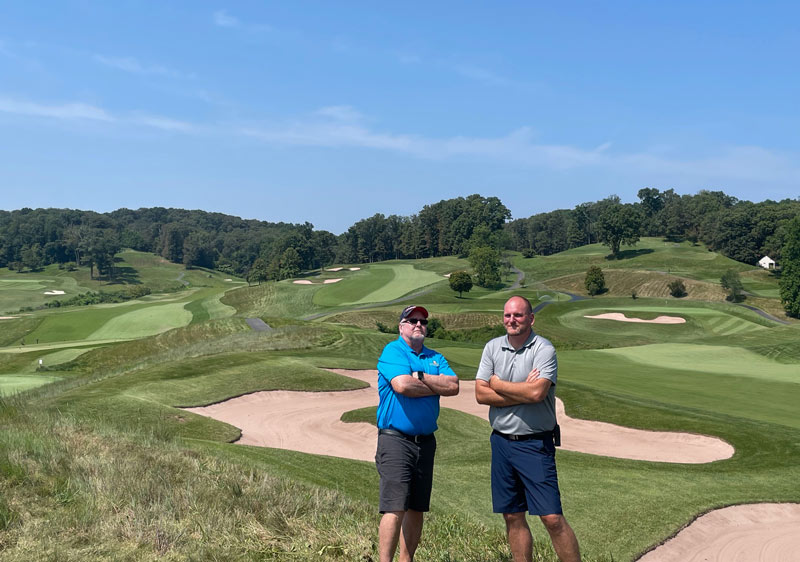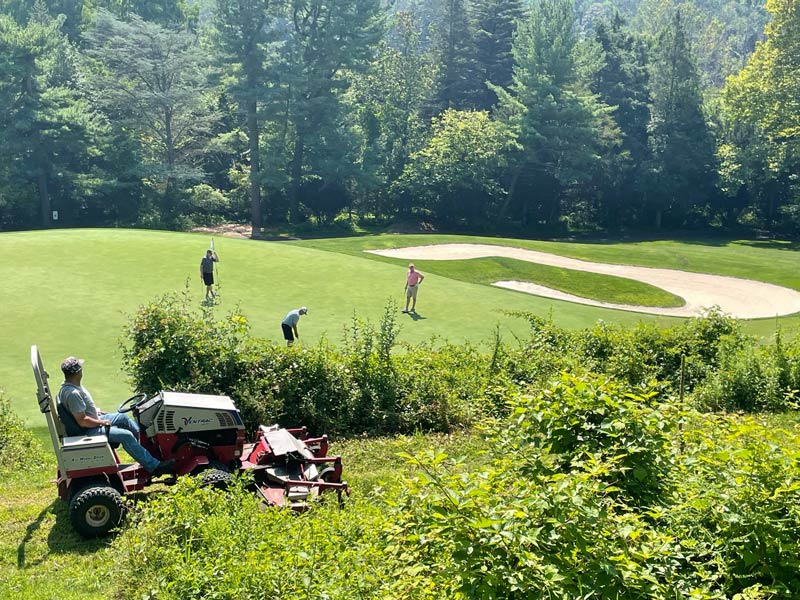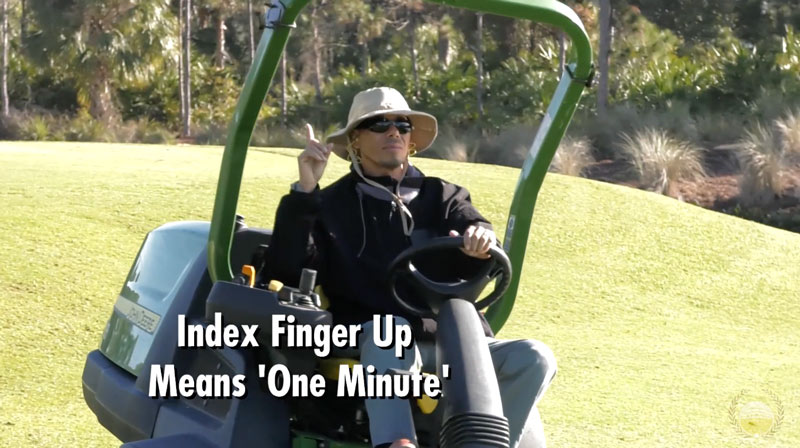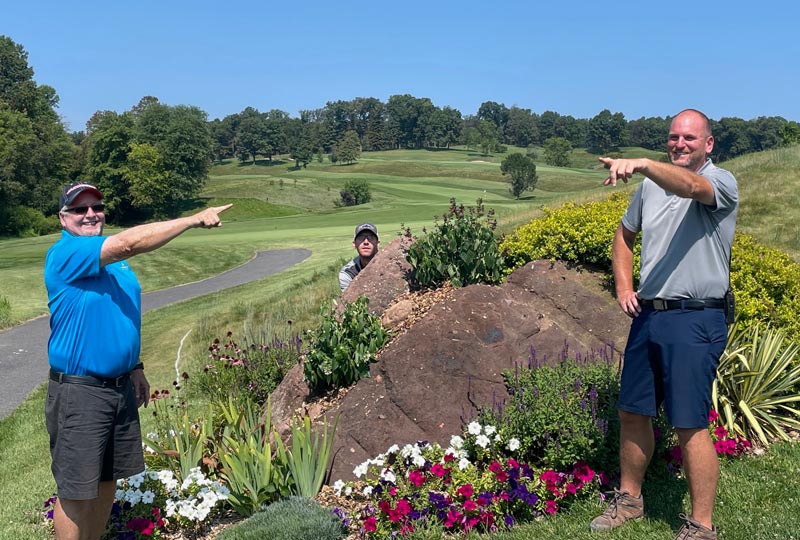Editor’s note: The following article was supplied by Golf Safety. All product claims, research cited and other information is directly from the company.
A golf course is a unique workplace. It’s an area of recreation and sport for visitors, and a place of pride and hard work for the crew. As a superintendent, you need to prioritize the safety of both the golfers and the crew on your premises. Flying golf balls can be a severe hazard — up to 40,000 people a year seek medical attention for injuries caused by golf ball impact. Golf course injuries caused by balls are even more common than injuries on the football field.

The Golf Safety team recently sat down with superintendent Alan FitzGerald, MG, to talk about safety when working near golfers. FitzGerald oversees LedgeRock Golf Club in southeast Pennsylvania. Spanning over 212 acres of former farmland, woodlands and nurseries, LedgeRock first opened its doors in 2006. FitzGerald, who recently attained his Master Greenkeeper certification from the British and International Golf Greenkeepers Association, has been at the helm of this Rees Jones gem for over 17 years. Here are some of his insights into how to avoid the hazards that golfers at play — and their stray balls — might present to your crew.

Tony Gustaitis from Golf Safety (left) with Alan FitzGerald, MG, at LedgeRock Golf Club. Photos courtesy of Golf Safety
When asked about his primary strategy for keeping his crew safe, FitzGerald states, “They try to get all the major work done ahead of play. So, mowing greens, rolling greens, mowing fairways, mowing tees and moving tee markers.” Adopting this strategy means that most of the major maintenance work your crew does will happen when golfers aren’t even on the course.
Unfortunately, every last bit of the maintenance work on your property can’t occur outside of play. There isn’t enough time. FitzGerald acknowledges this, too, specifically when it comes to maintenance of the roughs on the course. “Obviously, roughs are the one area we end up doing during play. We try to minimize it as much as we can,” he says. The crew at LedgeRock achieves this by making sure they always start a few holes ahead of any golfers playing a round. If the golfers catch up with the maintenance crew, the crew members are encouraged to stop for a few minutes and let the golfers pass.
When should the crew leave a hole that’s in play? “Within reason,” FitzGerald says. “We don’t tell them to leave (the hole) necessarily, but if they keep catching the same group, stop, go backward, do something.”

A LedgeRock Golf Club employee waits for golfers to finish before continuing with his task.
There are other ways that superintendents can prevent too much interaction between golfers and crew and reduce the risk of any injuries occurring. One of the most common ways is to start daily course maintenance as early as possible in the morning before the golfers arrive. Superintendents should discuss dangerous areas like blind tee shots or blind approach shots with their crew so that these can be avoided when the golf course is busy. FitzGerald says the best approach your crew can take in these areas is to “stop for five minutes and let the golfers through.”
It would help to encourage golfers to be mindful of your crew and to watch out for them. One way to promote this is to make your crew members more visible through a dress code. At LedgeRock, the uniform is a colored shirt — light gray. This makes maintenance staff easily recognizable.
FitzGerald admits he may be more fortunate than other superintendents because his club is closed on Tuesdays. This allows him to prioritize the safety of his maintenance crew. “On that day, we try to do fly-mowing, edging, and cleaning out bunkers,” he says. “We mow the driving range, and target greens.” These are all visible and quite invasive tasks during play, so it makes sense to do them when there are no club members around.
Doing maintenance on these days is more efficient, too. “Because there’s nobody out there, we can get through them quicker, and we don’t have to wait,” FitzGerald says. When there is a tournament or the course is jam-packed, FitzGerald pulls the whole maintenance team off the course. “If we have a full course tournament, we’re off,” he says. “When the shotgun goes out, everyone’s in the shop. We’ll do some safety meetings and clean up around the shop.”
When we asked FitzGerald about how he trains his crew to avoid being hit by golf balls, his response was, “Golf Safety’s videos.” Through these training sessions, he ensures the crew understands the dynamics of working near golfers. This way, crew members can decide when to back away from approaching golfers and when to just move on to a new hole.
For example, one of the important training points is that the average golfer hits the ball between 218 to 275 yards in the air. Once that ball bounces, it loses much of its force, but you sure do want to avoid it on the fly. If golfers are in this range, crew members need to keep their eyes on the golfer to avoid this hazard.
Like most superintendents, FitzGerald can recount any number of stories in which balls have come into the work area from 300-plus yards. As a superintendent, it’s crucial to equip your crew with the knowledge that enables them to make informed, situation-specific decisions. The rule of thumb is to stay out of an area where balls are still “on the fly,” but no two days on the golf course are ever precisely the same.

Another way a crew member can avoid getting hit by a ball is by communicating with club members. If the maintenance you need to perform is urgent but not drastic, training your crew on golfer communication will make their lives much easier. One index finger raised in the air indicates “One minute, please!” to golfers. Most golfers will wait for the crew to clear the area if they use this signal. Some clubs have a strict “members should never, ever see you” rule for crew members, but we know that’s not a viable option on most golf courses. A little bit of clear communication and a culture of mutual respect between your crew and club members can go a long way toward ensuring the safety of everyone on your course.

Some important strategies to help your crew to avoid injuries while working near golfers are:
- Try to get significant maintenance tasks done ahead of play.
- When you can’t do that, plan your routes to minimize crew encounters with golfers.
- Start your daily maintenance routine early in the morning.
- Make sure your crew is encouraged to pause and let golfers pass them when necessary.
- Encourage your crew to wear highly visible clothing and personal protective equipment.
- Take advantage of days when the course is closed to do big jobs.
- Try to keep most of the maintenance crew off the course during tournaments or hectic days.
- Make sure your crew knows how to stay out of the flying ball carry zone.
- Equip your crew with the training to make intelligent decisions and communicate with golfers.

Golf Safety’s Tony Gustaitis and LedgeRock Golf Club superintendent Alan FitzGerald joke about where employees can hide from golfers.
How do we know FitzGerald has the right idea here? First, because he trains his crew using the Golf Safety system. FitzGerald told us that since starting with Golf Safety, “All the frivolous accidents have disappeared, and our accident rate has dropped to zero for the last 10 years.” Second, because FitzGerald has over 20 years of experience in golf course management. And last, because he knows from experience just how dangerous stray balls are. When asked whether a stray ball has ever hit him, he said yes and told us just how much it hurt (a lot). When we asked why he got hit, he replied, chuckling, “Well, because I didn’t think the guy would hit me!”